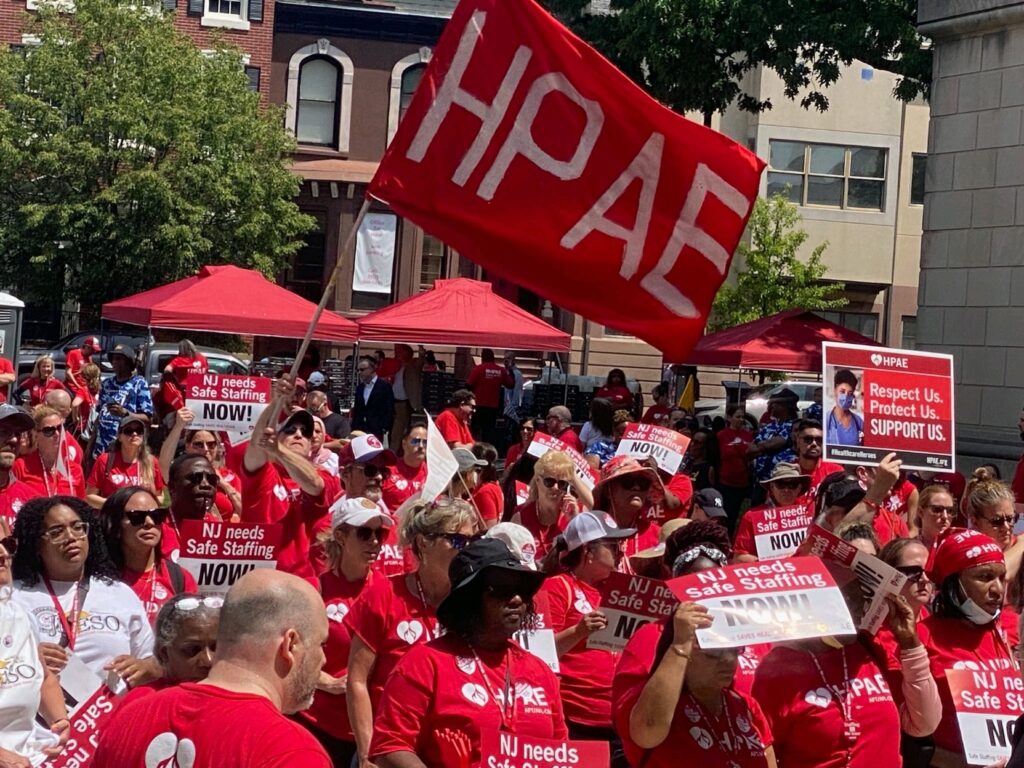Slashing of Healthcare Workers Spotlights Epidemic of Hospital Violence

Just before 7 a.m. on Dec. 8, two nurses and a medical resident on duty at the Newark’s Beth Israel Hospital’s pediatric intensive care unit were slashed by a 37-year-old female visitor, according to multiple press reports. All three hospital employees were treated in the hospital emergency room and their alleged attacker, Firdousi Abdul-Hakim was arrested and faces multiple charges for the incident that was being described as a domestic dispute with another hospital visitor.
Beth Israel, originally founded in 1901, is a 665-bed teaching hospital that’s part of the Robert Wood Johnson Barnabas network. In the immediate aftermath of the attack incoming patients were diverted to other area hospitals. Healthcare unions say the ICU attack is just the latest example of a troubling national trend of hospital workers being attacked on the job or experiencing terrifying close calls.
In July, a hospital security guard at Legacy Good Samaritan Medical Center in Portland Oregon was shot and killed and another employee was wounded after a verbal dispute between an armed visitor and hospital staff in a maternity ward escalated into a deadly encounter.
In September, healthcare workers and patients in Vineland’s Inspira Medical Center were caught up in an “active shooter” incident when a retired local police officer who had been admitted as a patient fatally shot himself.
“The crisis of violence against healthcare workers continues to plague our hospitals,” said Debbie White, RN, president of HPAE, the New Jersey’s largest nurses’ union, after the Beth Israel incident. “Healthcare workers are five times more likely to be assaulted in the workplace than any other profession.
Healthcare workers need to know they are safe and protected on the job. We are in the midst of a staffing crisis like we’ve never seen in history and the last thing we need is another reason for healthcare workers to migrate out of our hospitals.”
“Violence against healthcare workers is abhorrent,” said Rhina Molina, Executive Vice President at 1199SEIU. “1199SEIU members express our deepest sympathies and support for fellow caregivers at Newark Beth Israel who were attacked today. Workplace violence in the healthcare industry has turned into a national epidemic, with far greater rates than exist in other industries. It is crucial that our state and nation work towards ending this crisis and ensuring that every healthcare worker can do their job without fear.”
“How does something like this happen in a pediatric intensive care unit where these dedicated health professionals are in the process of caring for the most vulnerable patients – who is not paying attention?” asked Douglas Placa, Executive Director of JNESO District Council 1, IUOE-AFL-CIO, which represents thousands of nurses and technicians at four other acute care hospitals in New Jersey as well as in Pennsylvania.
According to Placa, there is no standard for hospital safety in the state, so each facility creates their own plan, and he told InsiderNJ several facilities have recently reduced their security teams to cut costs.
“This incident and recent increases in violence against health care workers are a huge wake-up call that something needs to be done now,” Placa said. “JNESO is sending a letter to all our facilities saying that we want them to immediately reevaluate all security measures to make sure they are stringent enough to keep health care workers – and their patients – safe!”
In May, in response to the spike in attacks on health care workers, Governor Phil Murphy signed the ‘Health Care Heroes Violence Prevention Act’. The bill made it a criminal offense “to intentionally threaten health care professionals or volunteers in an effort to intimidate them or interfere with their work. The act also establishes additional penalties against individuals who assault health care workers or volunteers,” according to a press release issued at the time.
“If there’s one thing the COVID-19 pandemic made abundantly clear, it is the essential role health care workers play in our society,” said Governor Murphy at the signing. “Growing threats and attacks against these courageous heroes are unacceptable. We owe health care workers, including volunteers and employees in health care settings, our gratitude and respect.”
“When the law was passed, we praised the sponsors, but also told them this bill didn’t go far enough,” said Placa. “Hospitals HAVE TO be held responsible for the safety of their own health care professionals, and we are going to continue to do whatever is necessary to put pressure on the facilities we serve to ensure the safety of our members.”
“This really a national epidemic of workplace violence nurses are dealing with, “ said Judy Danella, president of the United Steelworkers Nurses Local 4-200 which recently reached a tentative contract with Robert Wood Johnson University Hospital in New Brunswick after a strike that started back in August.
Last year, New Jersey Hospital Association’s Center for Health Analytics, Research and Transformation reported that the state’s hospitals posted a 14.6 percent in violent incidents in the state over the three prior years, , “increasing steadily from 8,691 in 2019 to 9,202 in 2020 to 9,962 in 2021.
“More than half of these incidents are related to physical abuse (an 11 percent increase in incidents between 2019 and 2021), and 44 percent are associated with verbal abuse (a 25 percent increase in incidents between 2019 and 2021),” report NJHA. “Less common incidents such as sexual harassment, racial harassment, and bullying are also on the rise. With its 24/7 public access, the most common location for workplace violence in the hospital is the emergency department, although hospitals report incidents occurring in various units.”
A coalition of New Jersey’s healthcare unions along with the New Jersey AFL-CIO are pressing Trenton lawmakers to adopt a statewide patient to nurse ratio similar to one adopted by California in 2004.
The bill’s boosters point to peer reviewed studies in the years since California enacted mandatory nurse to patient ratios that document improved patient outcomes, a reduction in the incidence of patient re-admittance to the hospital, a drop in workplace injuries, as well as a gain in nurse retention — a major challenge made more difficult by the pandemic which saw thousands of healthcare workers die due to their occupational exposure to COVID which killed 1.1 million Americans.
Back in August, the Associated Press reported that the latest “data shows American health care workers now suffer more nonfatal injuries from workplace violence than workers in any other profession, including law enforcement.”
“Health care workers don’t even think about that when they decide they want to be a nurse or a doctor. But as far as actual violence goes, statistically, health care is four or five times more dangerous than any other profession,” Michael D’Angelo, a former police officer and security consultant, told AP.
“According to the American College of Emergency Physicians (ACEP) approximately 80 percent of physicians believe that ED [emergency department] violence has impacted patient care and safety,” Time magazine reported last month. “In this high stress environment, 50 percent said that patients have been physically harmed, and 47 percent of emergency physicians have state that have been personally assaulted at work.
“Recent studies indicate, for example, that 44 percent of nurses reported experiencing physical violence and 68 percent reported experiencing verbal abuse during the COVID-19 pandemic,” according to an American Hospital Association fact sheet. “Workplace violence has severe consequences for the entire health care system. Not only does violence cause physical and psychological injury for health care workers, workplace violence and intimidation make it more difficult for nurses, doctors, and other clinical staff to provide quality patient care. Nurses and physicians cannot provide attentive care when they are afraid for their personal safety, distracted by disruptive patients and family members, or traumatized from prior violent interactions.”








Leave a Reply